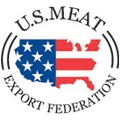 U.S. pork exports remained well ahead of last year’s record pace through February, while beef exports trended slightly lower in volume but posted excellent results in terms of value, according to statistics released by the USDA and compiled by the U.S. Meat Export Federation (USMEF).
U.S. pork exports remained well ahead of last year’s record pace through February, while beef exports trended slightly lower in volume but posted excellent results in terms of value, according to statistics released by the USDA and compiled by the U.S. Meat Export Federation (USMEF).
Pork export volume (187,629 metric tons) was 9 percent higher than in February 2011, while value ($526.2 million) was up 21 percent. For the first two months of the year, pork exports totaled 399,086 mt valued at $1.09 billion – increases of 18 percent and 31 percent, respectively. This is the first time U.S. pork export value has reached the $1 billion mark after only two months.

February beef export volume (87,131 mt) was 3 percent lower than a year ago but export value remained exceptionally strong, increasing 10 percent to $409 million. Through the first two months of the year, beef exports totaled 176,585 mt (-2 percent) valued at $815 million (+12 percent).
“Export results were quite solid, especially considering the impact of market access issues in some destinations, particularly Taiwan and Southeast Asia,” said USMEF President and CEO Philip Seng. “We continue to expand the presence of U.S. pork in all key destinations - especially in North Asia and in Western Hemisphere markets. In the beef complex, export volume may be struggling somewhat due to price, but we are having great success directing beef cuts to the markets that value them most. This is keeping beef export value very strong – well ahead of the record pace established last year.”
Value per head, percentage of total production very strong for U.S. pork
February pork exports equated to 27.7 percent of total production when including both muscle cuts and variety meat, 24 percent for muscle cuts only. This compares to 27 percent and 22 percent, respectively, in February 2011. Export value equated to $58.17 per hog slaughtered, up 14 percent from last year’s figure of $51.06.
Exports to Mexico, the largest volume market for U.S. pork, were lower than the record tonnage recorded in December and January but still outpaced last February’s results in both volume and value. For the year, exports to Mexico were up dramatically compared to the first two months of 2011 – increasing 20 percent in volume (113,424 mt) and 24 percent in value ($208 million).
Japan remains the value pacesetter for U.S. pork, as February exports were steady in volume with last year but still achieved an increase of 17 percent in value. Through February, 2012 exports to Japan were 8 percent higher than a year ago in volume (80,316 mt) and 22 percent higher in value ($342 million).
“It takes a strong effort at every level to keep these mainstay markets performing at such a strong pace,” Seng explained. “The retail, foodservice and processing sectors are all critically important to the U.S. industry’s ability to remain the leading supplier to both Japan and Mexico, and USMEF continues to target them aggressively. We also are very focused on the branded market in Japan, which offers fertile ground for expanding sales of U.S. pork.”
Other pork export highlights for the first two months of 2012 include:
- Exports to China/Hong Kong were 39 percent higher in volume (78,193 mt) and nearly doubled in value ($158.2 million, up 94 percent). February volume, however, was the smallest since June 2011.
- Exports to Canada increased 36 percent in volume (36,484 mt) and 45 percent in value ($129.9 million).
- While lower tariff rates prescribed in the Korea-U.S. FTA did not take effect until mid-March, exports to South Korea increased 11 percent in volume (36,399 mt) and 28 percent in value ($104 million).
- Exports to Australia were one-third higher in both volume (12,423 mt) and value ($38.9 million).
- Led by strong demand in Chile and Colombia, exports to the Central and South America region increased 18 percent in volume (13,091 mt) and 23 percent in value ($34.8 million).
Destinations where export volume was lower for the year included Taiwan (steady in value at $10.4 million but down 19 percent in volume to 4,693 mt), where the controversy over ractopamine residues has created an uncertain business climate and lowered imports from all sources. Regulatory issues in the Philippines and Singapore held back exports to the ASEAN region, where export value ($18.3 million) still achieved a small increase despite an 18 percent decline in volume (7,169 mt).
April 12, 2012 - U.S. Meat Export Federation (USMEF)


